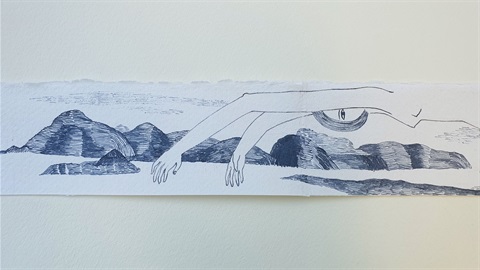Yuan Liu: Sand Chronicles

In response to Tim Storrier’s 1985 painting Poet, featured in his solo exhibition Ticket to Egypt (1986), Sand Chronicles consists of a series of pocket-size concertina books with drawings reminiscent of the vast landscape observed from a sleeper train connecting Cairo, Luxor and Aswan. Through the train window, the world unfurls as a continuous strip of landscape, ever-present yet ephemeral.
Seeking to recreate the sense of never-ending narratives along the horizon, these minuscule drawings traverse dunes, rolling hills, monuments built with limestone or carved out of sandstone, and the ochre wind gliding through the valleys. The use of a strip of paper, a fountain pen and a bottle of pale obsidian ink recalls the pragmatic approach of a traveller with limited resources, while the repeated lines form shapes that echo the ‘unencumbered culture from a topographical point view’ that enchanted Storrier – ‘just a river, fields and sand with these incredible monoliths and monuments in the middle of it’.
Some of the drawings contemplate the UNESCO campaign during 1960s–1980s to salvage the Nubian monuments from Abu Simbel to Philae, when the rising water level of the Nile, largely due to the construction of the Aswan High Dam, threatened to submerge a number of monuments in this archaeological area. Now, the colossal statues of Ramses II, fronting one of the Abu Simbel temples, stand 64 meters above its original site and 180 meters inland. The sanctuary of goddess Isis at Philae has been moved to the adjacent Agilkia Island, before the Island of Philae became completely submerged under Lake Nasser.
Central to Storrier’s Poet is the imagery of a detached foot. If we read his painting literally, questions may arise: was the body looted, leaving the one foot on the pedestal, a story not uncommon in human history? Or was it set ablaze, with only the foot remaining with smouldering fire from beneath? Perhaps, as Linda van Nunen puts it in her book Point to Point: the art of Tim Storrier, some of Storrier’s images ‘deal with temporality, the ephemeral nature of power and the Ozymandian vanity of the mighty’. A foot on fire or monuments submerged under water becomes a symbol of the impermanence of man-made structures. The drawings also strive to convey a sense of absurdity, ruminating on the hubris to achieve immortality and outpace decay.
The windows in the exhibition space overlooks Lake Macquarie, a body of coastal saltwater that sustains diverse habitats including mangroves, saltmarsh, reefs, sand flats and mud flats. Its juxtaposition with these tiny drawings is an invitation to ponder on the connection between the untouched natural land and MAC yapang, meaning journey/pathway in the language of the Awabakal people.
Image: Yuan Liu, Sand Chronicles (detail) no. 4. pen on paper.
When
Past event dates
-
Saturday, 19 October 2024 | 09:00 AM
- Sunday, 08 December 2024 | 03:00 PM
Location
Museum of Art and Culture, 1A First Street, Booragul 2284, 2284, View in Google Maps
-32.9741768,151.6156563
1A First Street, Booragul 2284 ,
2284
Museum of Art and Culture
1A First Street, Booragul 2284 ,
2284
Yuan Liu: Sand Chronicles
Google Map Instructions
Press arrow keys to pan
Press plus or minus keys to zoom
Shortcut keys
Press M for roadmap view
Press S for satellite view
Press H for hybrid view
Press T for terrain view
To navigate, press the arrow keys.